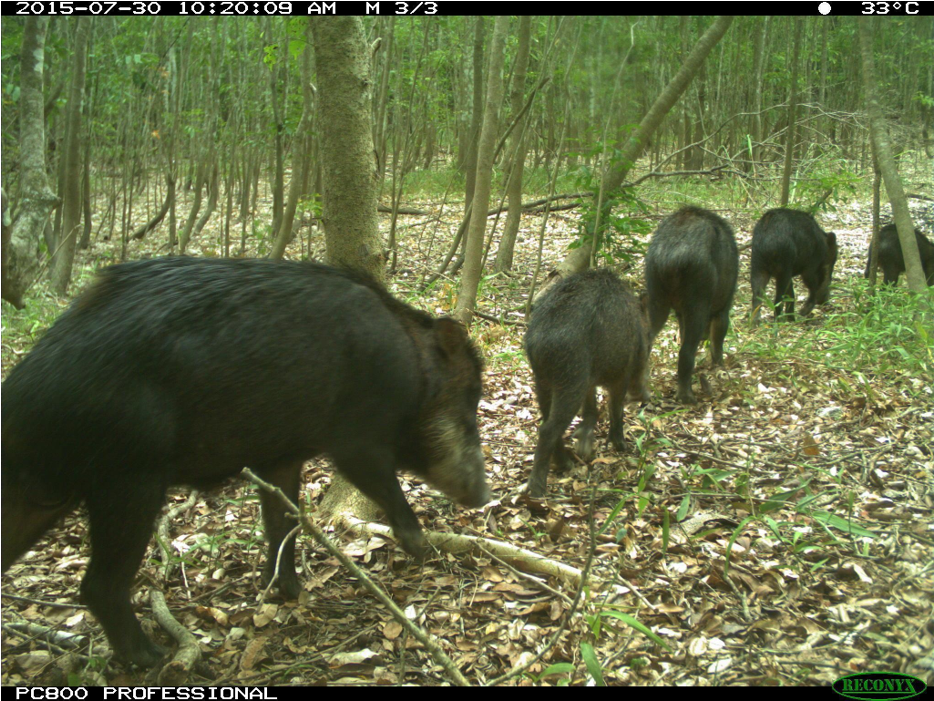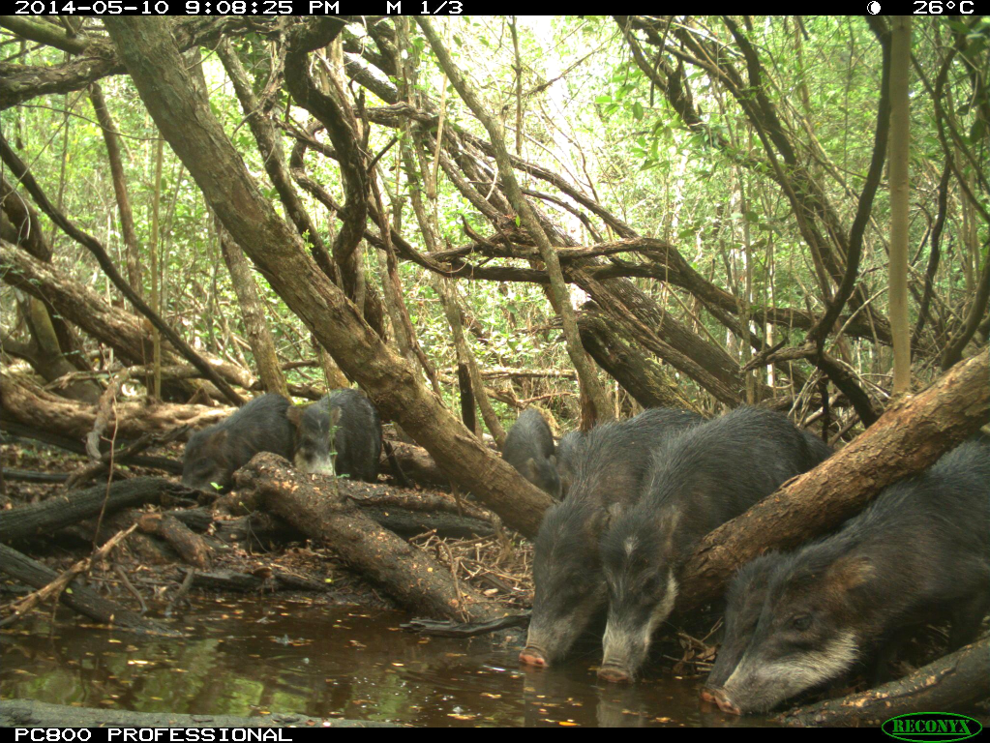- White-lipped peccaries, the pig-like mammals that range from Mexico to Argentina, are in “precipitous decline” in their Mesoamerican range, according to a new study.
- Their numbers in this region may have dropped by as much as 90% over the past 40 years, sparking a push for a new conservation assessment.
- The main threat to the species is the destruction of its rainforest habitat, largely attributed to the expansion of agriculture and cattle pasture.
- Conservationists say the loss of peccaries will have significant ramifications for rainforest ecosystems, which the animals are important in shaping through seed dispersal, tree control, and creation of watering holes.
In 2000, Dr. Rafael Reyna-Hurtado spotted a herd of white-lipped peccaries (Tayassu pecari) for the first time in the Mayan Forest. The sight, he says, took his breath away. Never before in his life had he seen nearly a hundred animals of the same species move so steadfastly, perfectly in a straight line, he says.
“I was amazed,” Reyna-Hurtado says of unexpectedly encountering them while helping a friend study tropical deer in Mexico. “It’s a reason why I wanted to study peccaries.”
The white-lipped peccary is a heavy, pig-like mammal, most easily identified by the white markings under its snout. It feeds mainly on fruits, vegetation, roots and insects, and, less occasionally, small vertebrates like frogs and lizards. This peccary is most commonly found in the rainforests spanning Mexico to Argentina.

Twenty years after his first encounter, Reyna-Hurtado is sounding the alarm on the dramatic decline of the white-lipped peccary. In a paper published in February, Reyna-Hurtado and colleagues found the white-lipped peccary population in Mesoamerica, the region that runs from Central Mexico down to Costa Rica, has declined by as much as 87 to 90% over the past 40 years — a decline that is nearly two-thirds higher than the IUCN’s previous estimates.
Published in the journal Biological Conservation, the study is the combined effort of 50 scientists and urges a reassessment of the white-lipped peccary’s conservation status and needs. Currently, the IUCN classifies white-lipped peccaries as vulnerable, but the study posits the status of the species is closer to endangered, particularly in Mesoamerica.
Herd life makes peccaries vulnerable
Over two decades of research, Reyna-Hurtado has found that the white-lipped peccaries’ life in herds that range from 100 to 300 animals makes them especially vulnerable to human activity. There are two reasons for this: large herds are easy targets for hunters, and they can’t survive in fragmented, deforested areas.
“This is the first species that disappears when humans colonize new habitats, as ‘white-lips’ disappear even before tapirs and jaguars,” Reyna-Hurtado says.
While hunting is a severe threat, Reyna-Hurtado says he believes deforestation is the larger cause of peccary decline, since the species requires vast expanses of rainforest to survive. With people logging and burning forests in Mesoamerica for agriculture, livestock, wood and construction, peccaries are taking a hit. Reyna-Hurtado estimates that a normal-sized peccary herd requires 100 to 120 square kilometers (39 to 46 square miles) to safely roam — a requirement that is increasingly difficult to find.
In particular, Reyna-Hurtado points to the cattle industry as one of the most notorious for pushing white-lipped peccaries off their habitat.
“Cattle-ranching is a big threat for all tropical forests in Mesoamerica,” he says. “[A]s we lose pristine forest, we will lose more white-lipped peccaries. This species is the indicator of pristine forest — if we have white-lipped peccaries, that means the forest is in the best conservation status.”
While Mesoamerica is losing its white-lipped peccaries at the most alarming rate, other regions where the species occurs are witnessing a decline too. Dr. Harald Beck, professor at Towson University and co-chair of the IUCN Peccary Specialist Group, estimates they’ve experienced a 40 to 50% decline in South America. In the Amazon, as in Mesoamerican forests, white-lipped peccaries are declining due to hunting and deforestation.
“Tens of thousands of fires have been set all over primarily Brazil, Peru, and Bolivia to open up the rainforest for agriculture,” Beck says.
Gardeners of the forest
Reyna-Hurtado and Beck both emphasize the importance of white-lipped peccaries to rainforest ecology. By moving in vast herds and trekking long distances, white-lipped peccaries play an important role in moving soil and maintaining a balance of various plant species in the forest.
“This is a species that keeps forest diversity by killing seeds of trees that otherwise will dominate the tropical forest,” Reyna-Hurtado says.
At the same time, these peccaries disperse seeds through the fruits they eat, increasing biodiversity and the range of these plants.
“They are like the gardeners of the forest,” Reyna-Hurtado adds.
White-lipped peccaries also perform ecological services for other wildlife. They create deep wallows in the rainforest soil to clean and cool themselves, which then serve as an important water source not only for peccaries, but also for other animals living in the rainforest.

“Because the soil is moved into a deeper depression, [the wallows] become a breeding ground for a lot of amphibians,” Beck says.
Beck says he has witnessed other animals take advantage of the wallows during the rainforest dry season, some of them completely unexpected: fish from the local rivers relocating to the wallows; jaguars bathing in the water; and even bats and owls cooling down in the soil at night.
“It’s really a remarkable story,” Beck says, calling these peccary wallows “islands of biodiversity.”
But the drastic decline of white-lipped peccaries across Mesoamerica and South America has begun taking a toll on rainforest ecosystems. Scientists have witnessed the local extinction of three frog species that once depended on peccary wallows for breeding.
Reyna-Hurtado and Beck, both of whom consider the white-lipped peccary a keystone species, say the ongoing decline will drive further changes on the rainforest floor, as well as reduced diversity in plants and wildlife.
“If there’s no enforcement, if there’s no protection, then it’s really hard in the near future to see peccaries having a chance to come back,” Beck says. “The pressure [on white-lipped peccaries] just keeps increasing.”
A new assessment
Beck and Reyna-Hurtado, a member of the IUCN Peccary Specialist Group, say a reassessment of the white-lipped peccary’s conservation status is necessary.
“Rafael’s paper was really an alarm call for all of us in that we need to reassess it,” Beck says. “It’s overdue, it was around eight years ago that we did the last assessment. The Red List does not reflect reality and this needs to be changed.”
However, both say a new IUCN assessment should be only the first step in what needs to be a more ambitious conservation approach.
“The IUCN is only a label,” Reyna-Hurtado says. “But we hope that label will help people and governments to take real actions such as stopping hunting and protecting forests.”
Another member of the IUCN Peccary Specialist Group, Alexine Keuroghlian, is taking direct action to ensure conservation efforts. In 2000, she founded the Peccary Project to track the displacement of white-lipped peccary populations in Brazil. She also works directly with ICMBio, Brazil’s federal institute for biodiversity conservation, to develop a national conservation plan to protect peccaries and similar species.

In addition to an IUCN reassessment, Keuroghlian also recommends investment in more sustainable agricultural practices, increased enforcement against illegal hunting and land use, the creation of new conservation units and corridors, and an implementation of reintroduction efforts in areas where white-lipped peccaries have gone extinct.
She says conservation efforts must address the multifaceted and complex causes of the white-lipped peccaries’ decline, as these causes are not isolated and are more interconnected than they appear.
“In highly deforested and fragmented biomes, like the Atlantic Forest and Cerrado, habitat loss is probably the main driver of declines initially,” Keuroghlian says. “But with fragmentation, hunters gain greater access to the herds, causing additional population declines.”
While most of us will never encounter a white-lipped peccary herd in real life, our dinner plans may be contributing to their decline.
“There is clearly a link to our meat consumption with the demand for beef, which of course has to be grown somewhere,” Beck says.
That “somewhere” is increasingly over the ashes of rainforests in Mesoamerica and South America, razed to make room for cattle ranches. Inevitably, the destruction of these rainforests takes the herds of precious white-lipped peccaries with it.
Citations:
Beck, H., Thebpanya, P., & Filiaggi, M. (2010). Do Neotropical peccary species (Tayassuidae) function as ecosystem engineers for anurans? Journal of Tropical Ecology, 26(4), 407-414. doi:10.1017/s0266467410000106
Keuroghlian, A., Santos, M. C. A., & Eaton, D. P. (2015). The effects of deforestation on white-lipped peccary (Tayassu pecari) home range in the southern Pantanal. Mammalia, 79(4), 491-497. doi:10.1515/mammalia-2014-0094
Thornton, D., Reyna, R., Perera-Romero, L., Radachowsky, J., Hidalgo-Mihart, M. G., Garcia, R., … & Polisar, J. (2020). Precipitous decline of white-lipped peccary populations in Mesoamerica. Biological Conservation, 242, 108410. doi:10.1016/j.biocon.2020.108410
CORRECTION (7/23/2020): A previous version of this article wrongly stated that Dr. Harald Beck is an assistant professor at Towson University. Dr. Beck is a Professor there. That version also incorrectly stated that Dr. Beck had witnessed the extinction of 3 frogs that depended on peccary wallows for breeding. The local extinctions were witnessed by different scientists.
